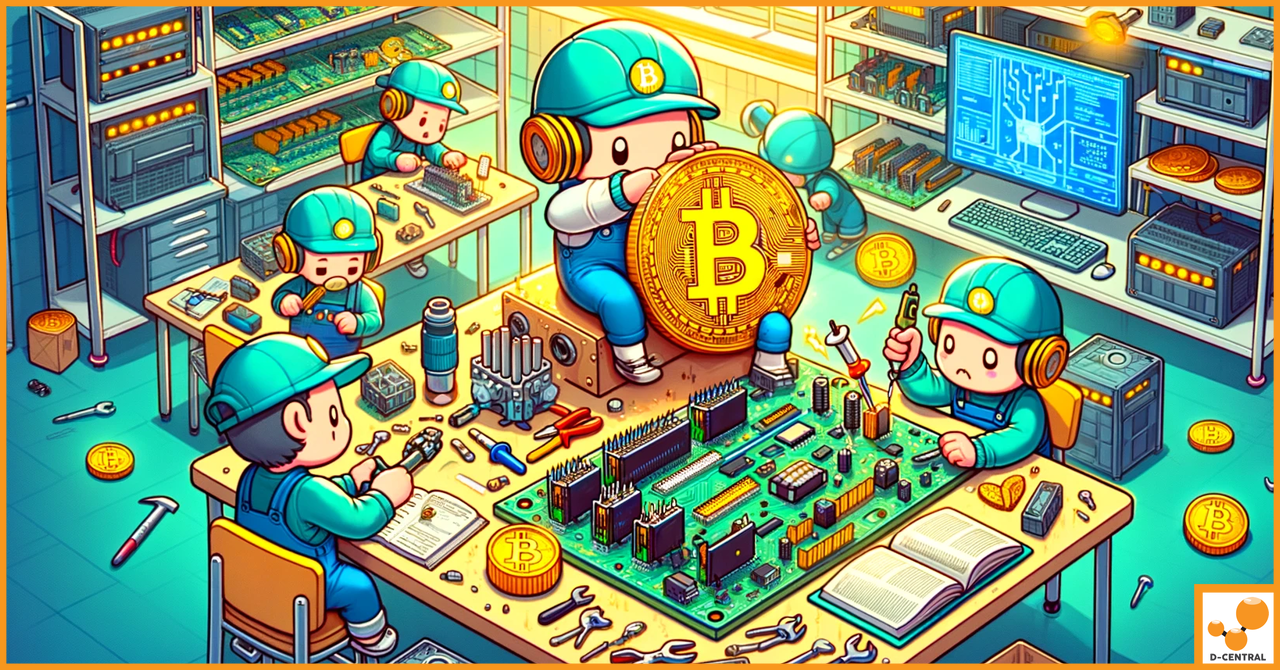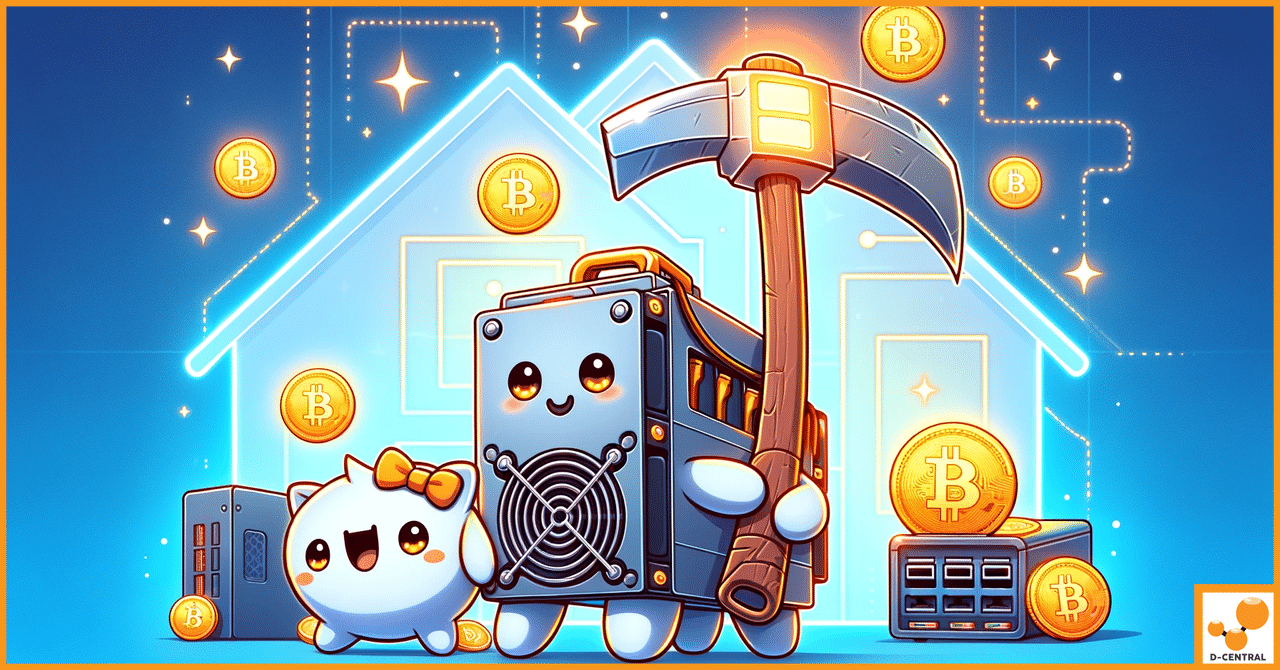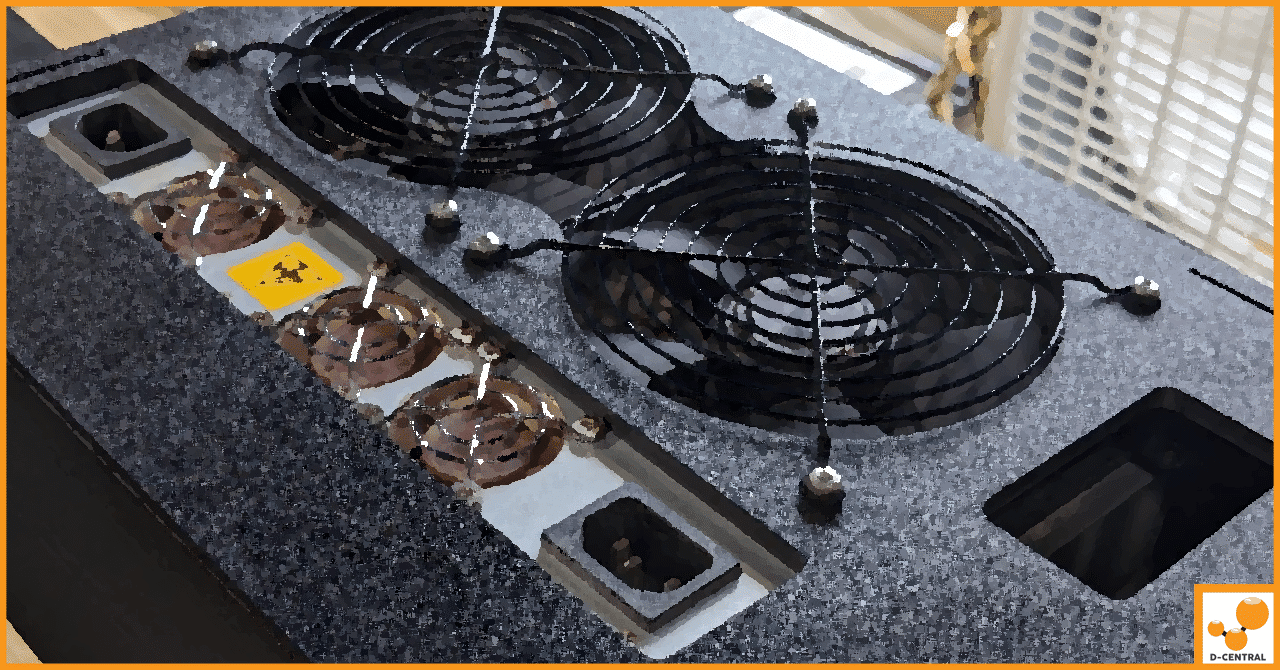
Bitcoin Multisig Escrow: Revolutionizing Secure P2P Trading
In the ever-evolving landscape of digital finance, Bitcoin has emerged as a revolutionary force, reshaping the way we think about
4479 Desserte Nord Autoroute 440, Laval, QC H7P 6E2

In the rapidly evolving world of digital currencies, cryptocurrency mining stands as a cornerstone activity, driving the validation and security of transactions on various blockchain networks. This process, which involves solving complex mathematical problems to earn cryptocurrencies, is not just pivotal for the functioning of blockchain technology but also offers a lucrative opportunity for individuals and enterprises alike. However, the efficiency and profitability of mining are heavily dependent on the performance and reliability of mining hardware.
Mining hardware, such as Application-Specific Integrated Circuits (ASICs), Graphics Processing Units (GPUs), and Field-Programmable Gate Arrays (FPGAs), are the workhorses of cryptocurrency mining. These specialized devices are designed to execute the hashing algorithms necessary for mining cryptocurrencies like Bitcoin, Ethereum, and others. Given the intense competition and the continuous operation required in mining activities, these devices are subjected to significant stress, leading to wear and tear, overheating, and other issues that can impede their functionality.
The importance of maintaining and repairing mining hardware cannot be overstated. Regular maintenance ensures that mining operations run smoothly and efficiently, maximizing the potential for profit. Conversely, neglected hardware can lead to increased downtime, reduced mining output, and potentially costly repairs or replacements. In essence, the health of mining hardware directly influences the miner’s bottom line.
Recognizing the critical role of mining hardware in the cryptocurrency ecosystem, this article aims to provide a detailed guide on professional-level repair and maintenance of cryptocurrency mining hardware. From routine maintenance to advanced repair techniques, we will cover essential practices and insights to help miners optimize the performance and longevity of their mining equipment. Whether you’re a seasoned miner or new to the field, this comprehensive guide will equip you with the knowledge and skills needed to maintain your mining hardware at peak efficiency, ensuring that your mining endeavors remain profitable and sustainable in the long run.
Cryptocurrency mining hardware is the backbone of the mining process, enabling miners to secure blockchain networks and validate transactions. The choice of hardware significantly affects the efficiency, profitability, and sustainability of mining operations. Understanding the types of mining hardware, their common models, and the role of each component is crucial for anyone involved in cryptocurrency mining.
ASICs are specialized hardware designed exclusively for mining cryptocurrencies. They are optimized to compute mining algorithms with unparalleled efficiency. Due to their design, ASICs can outperform general-purpose hardware like CPUs and GPUs in terms of hashing speed and energy consumption. However, their specialization means they can only mine specific cryptocurrencies, making them less flexible than other types of mining hardware.
GPUs are versatile components originally designed to render graphics in video games. However, their parallel processing capabilities make them suitable for mining cryptocurrencies, especially those with algorithms resistant to ASIC optimization. GPUs are favored for their flexibility, as they can mine multiple types of cryptocurrencies and are also usable for other computational tasks outside of mining.
FPGAs are integrated circuits that miners can configure or “program” after manufacturing to perform specific tasks, including cryptocurrency mining. They offer a balance between the flexibility of GPUs and the efficiency of ASICs. FPGAs can be reprogrammed for different mining algorithms, providing adaptability to changing mining landscapes without the need for new hardware.
Each component in a mining rig plays a critical role in the mining process:
Understanding the types of mining hardware, the common models used in operations, and the role of each component is fundamental for anyone looking to engage in cryptocurrency mining. This knowledge not only aids in selecting the right equipment for specific mining goals but also underscores the importance of regular maintenance and repair to ensure the longevity and productivity of mining investments.
Cryptocurrency mining hardware, while designed for durability and continuous operation, is not immune to a range of issues that can affect its efficiency and longevity. Understanding these common problems is crucial for maintaining optimal mining operations. Here’s a look at some of the most prevalent issues faced by mining hardware and how they can be addressed.
Hardware failures in mining rigs can range from malfunctioning processing units (GPUs, ASICs) to faulty motherboards or memory modules. Such failures often result in significant downtime, reduced hash rates, and, consequently, lower mining rewards. Identifying the early signs of hardware failure, such as unexpected shutdowns, reduced performance, or error messages, is key to mitigating these impacts. Regular maintenance and monitoring can help detect these issues early, allowing for timely repairs or replacements.
Overheating is one of the most common issues in mining operations, primarily caused by inadequate cooling, high ambient temperatures, or dust buildup within the hardware. The consequences of overheating can be severe, including hardware throttling, reduced lifespan of components, and in extreme cases, permanent damage. To prevent overheating, ensure that your mining setup has adequate cooling solutions, such as high-quality fans and heat sinks. Regular cleaning to remove dust and maintaining an optimal operating environment can also significantly reduce the risk of overheating.
Power supply issues can stem from using an inadequate or failing power supply unit (PSU) that cannot meet the energy demands of the mining hardware. Symptoms include random reboots, instability, and hardware not powering on. Using a PSU with sufficient wattage and efficiency rating for your mining rig is crucial. Regularly inspecting the PSU for signs of wear, such as swollen capacitors or unusual noises, can help identify problems early. Replacing a faulty PSU promptly is essential to prevent further damage to the mining hardware.
Firmware issues and software glitches can cause a range of problems, from reduced mining efficiency to complete operational failures. These can be due to outdated firmware, software incompatibilities, or bugs in the mining software. Keeping the firmware of your mining hardware updated and using stable, reputable mining software can help minimize these issues. Regular backups and cautious updates, ideally tested on a smaller scale before full deployment, can prevent significant disruptions.
Continuous operation subjects mining hardware to wear and tear, gradually degrading its performance and reliability. Signs of wear and tear include increased error rates, reduced hashing power, and more frequent hardware failures. To address wear and tear, conduct regular inspections of your mining hardware for any physical signs of deterioration, such as damaged cables or connectors, and listen for unusual sounds that may indicate failing components. Replacing worn-out parts before they fail can help maintain the efficiency and prolong the lifespan of your mining hardware.
Recognizing and addressing the common issues with mining hardware is essential for maintaining optimal mining operations. Regular maintenance, monitoring, and timely interventions can prevent minor issues from escalating into major problems, ensuring your mining hardware remains productive and profitable over time.
Maintaining cryptocurrency mining hardware is crucial for ensuring the longevity and efficiency of your mining operations. Regular maintenance not only helps in preventing hardware issues but also maximizes the profitability of your mining activities. Here’s a comprehensive guide to the essentials of mining hardware maintenance.
A well-structured routine maintenance checklist is vital for keeping your mining hardware in top condition. Here are the key tasks that should be part of your maintenance routine:
Dust accumulation is a common problem that can significantly impact the performance and lifespan of mining hardware. Here are some best practices for cleaning and dusting your mining equipment:
An effective cooling system is essential for maintaining optimal operating temperatures and preventing overheating. Here’s how to maintain your cooling system:
Keeping the firmware of your mining hardware and the mining software updated is crucial for security and performance:
Adhering to these maintenance essentials can significantly enhance the performance and extend the lifespan of your cryptocurrency mining hardware. Regular maintenance not only prevents potential downtimes but also ensures that your mining operation remains profitable in the long run.
Maintaining and repairing cryptocurrency mining hardware is crucial for ensuring the efficiency and longevity of your mining operations. This guide provides a structured approach to diagnosing and repairing common hardware issues, ensuring your mining setup remains productive.
By following this step-by-step guide, miners can effectively diagnose and repair their mining hardware, ensuring minimal downtime and maintaining optimal mining efficiency. Regular maintenance, combined with timely repairs, is key to a profitable and sustainable mining operation.
As cryptocurrency mining hardware becomes increasingly sophisticated, the ability to perform advanced repairs is essential for maintaining operational efficiency and extending the lifespan of mining equipment. This section delves into advanced repair techniques, including soldering, circuit board repairs, and the use of diagnostic software. It also provides guidance on when it might be necessary to seek professional help.
Soldering is a fundamental skill for repairing electronic components on mining hardware circuit boards. It involves melting solder around a connection to secure components like capacitors, resistors, and integrated circuits.
Advanced diagnostic software and tools can provide a deeper insight into the health and performance of mining hardware.
While many repairs can be performed with the right tools and knowledge, some situations require the expertise of a professional.
Advanced repair techniques can significantly extend the life of cryptocurrency mining hardware. However, recognizing the limits of DIY repairs and knowing when to seek professional assistance is crucial for ensuring the continued performance and reliability of your mining operations.
In the realm of cryptocurrency mining hardware maintenance, the decision between undertaking repairs yourself (DIY) and opting for professional repair services is pivotal. Each approach has its merits and drawbacks, influenced by factors such as cost, expertise, and the complexity of the repair. Understanding these can help miners make informed decisions that best suit their needs and capabilities.
The choice between DIY and professional repair services for cryptocurrency mining hardware depends on the nature of the problem, your own skills and resources, and the value of the equipment. While DIY repairs can be cost-effective and educational, professional services offer expertise, specialized equipment, and warranties that can be crucial for complex or high-stakes repairs. By carefully weighing these factors and diligently researching potential repair services, miners can ensure their hardware receives the best possible care.
For cryptocurrency miners, having the right set of tools and equipment for hardware repair is not just about fixing immediate problems; it’s about ensuring the longevity and optimal performance of their mining setup. Investing in high-quality and reliable repair equipment can save time and money in the long run by enabling efficient, in-house troubleshooting and maintenance. Here’s a guide to assembling a comprehensive repair kit for mining hardware maintenance.
A digital multimeter is indispensable for diagnosing electrical issues, measuring voltage, current, and resistance. It helps in pinpointing problems with power supplies, identifying faulty components, and ensuring electrical connections are correct.
For repairing or replacing components on circuit boards, a good soldering iron with adjustable temperature control is crucial. The kit should include different tips for various soldering needs, solder wire, flux, and a desoldering pump or wick for removing old solder.
These tools are invaluable for detecting overheating components within your mining hardware. Identifying hot spots can help in addressing cooling issues before they lead to hardware failure.
A set of precision screwdrivers with various sizes and types of heads (Phillips, flathead, Torx) is essential for disassembling and reassembling mining hardware, which often features small and delicate screws.
Dust accumulation can significantly impact the performance and cooling efficiency of mining hardware. Compressed air is perfect for cleaning out dust from hard-to-reach areas without damaging components.
Working with electronic components requires precautions against ESD, which can damage sensitive parts. An ESD wrist strap and an ESD mat are critical for creating a safe working environment.
When selecting tools and equipment for your repair kit, opt for reputable brands known for their durability and precision. While it might be tempting to go for cheaper options, investing in high-quality tools pays off in the reliability and accuracy they provide, which can be the difference between a successful repair and costly damage. Brands like Fluke for multimeters, Hakko and Weller for soldering equipment, and iFixit for precision screwdrivers are well-regarded in the electronics repair community.
In addition to the essential tools listed above, consider including the following items in your mining hardware repair kit:
By carefully selecting and investing in the right tools and equipment, cryptocurrency miners can significantly enhance their ability to maintain and repair their mining hardware. A well-equipped repair kit not only enables efficient troubleshooting and fixes but also empowers miners to keep their operations running smoothly, maximizing uptime and profitability.
In the dynamic world of cryptocurrency mining, staying informed and continuously improving one’s knowledge is crucial for success. The collective wisdom of the mining community can be an invaluable resource for both newcomers and seasoned miners. Engaging with online forums, participating in workshops, and enrolling in courses are excellent ways to learn, share knowledge, and stay ahead in the rapidly evolving mining landscape.
Online forums and communities are treasure troves of information, offering insights, advice, and support for cryptocurrency miners. Platforms such as Bitcointalk, Reddit (subreddits like r/BitcoinMining and r/EtherMining), and specialized forums on websites like CryptoCompare provide spaces for miners to discuss strategies, hardware, and mining pools. These forums are also great for troubleshooting, as members often share their experiences and solutions to common problems.
For those looking to deepen their technical knowledge and skills, workshops, webinars, and online courses offer structured learning opportunities. These educational resources cover a wide range of topics, from basic maintenance to advanced repair techniques.
The cryptocurrency mining sector is characterized by rapid technological advancements and frequent market fluctuations. Staying updated and continuously learning is not just beneficial but necessary for maintaining competitive edge and operational efficiency.
Joining the cryptocurrency mining community and engaging in continuous learning and knowledge sharing are fundamental for anyone looking to thrive in this field. Whether through online forums, educational resources, or community events, connecting with fellow miners offers invaluable opportunities for growth, innovation, and success.
The journey through the intricacies of cryptocurrency mining hardware maintenance and repair underscores a fundamental truth: the health and efficiency of mining operations are directly tied to the care and expertise applied to the hardware that powers them. From routine maintenance to advanced repair techniques, the ability to address and preempt hardware issues is indispensable for maximizing uptime, ensuring profitability, and sustaining the long-term viability of mining endeavors.
The importance of maintaining and repairing mining hardware cannot be overstated. Regular maintenance not only prevents costly downtime and extends the lifespan of mining equipment but also optimizes mining efficiency, ensuring that every watt of power translates into the highest possible hash rate. Meanwhile, developing the skills to perform both basic and advanced repairs empowers miners to swiftly address issues, reducing reliance on external repair services and minimizing operational disruptions.
Investing time in learning about hardware maintenance and repair is an investment in the future of your mining operations. The landscape of cryptocurrency mining is one of constant evolution, with new technologies, algorithms, and challenges emerging regularly. By embracing continuous learning and staying engaged with the mining community, miners can adapt to these changes, adopting best practices and leveraging collective knowledge to navigate the complexities of mining hardware upkeep.
In conclusion, the proactive maintenance and repair of mining hardware are foundational to the success and sustainability of cryptocurrency mining. As the sector continues to evolve, the miners who dedicate themselves to understanding and caring for their equipment will be best positioned to thrive. Embrace the ethos of continuous improvement and community engagement, and let these principles guide your path to mining excellence in the dynamic and ever-changing world of cryptocurrency.
What is cryptocurrency mining and why is hardware maintenance important?
Cryptocurrency mining is the process of solving complex mathematical problems to validate transactions and ensure the security of a blockchain network. Hardware maintenance is crucial because the efficiency and profitability of mining depend heavily on the performance and reliability of mining hardware.
What are the common types of mining hardware?
The most common types of mining hardware include Application-Specific Integrated Circuits (ASICs), Graphics Processing Units (GPUs), and Field-Programmable Gate Arrays (FPGAs). These devices are designed to execute the hashing algorithms necessary for mining cryptocurrencies.
What are some common issues with mining hardware?
Common issues with mining hardware include hardware failures, overheating, power supply problems, firmware and software glitches, and general wear and tear. These issues can affect mining efficiency and hardware longevity.
What are the essentials of mining hardware maintenance?
Essentials of mining hardware maintenance include routine visual inspections, cleaning and dusting, cooling system checks, firmware and software updates, power supply checks, and monitoring of hash rates. These practices help maintain optimal performance and prevent potential issues.
How should you approach repairing mining hardware?
Repairing mining hardware involves initial diagnosis using tools like multimeters and thermal cameras, safety precautions, disassembling and inspecting hardware, troubleshooting common problems, replacing faulty components, and testing hardware post-repair for performance and stability.
What are advanced repair techniques for mining hardware?
Advanced repair techniques include soldering and circuit board repairs, using diagnostic software and tools for in-depth analysis, and understanding when to seek professional help for complex repairs or issues that require specialized equipment or skills.
Should you opt for DIY or professional repair services?
The choice between DIY or professional repair services depends on the complexity of the repair, your own skills, the value of the equipment, and whether the hardware is still under warranty. Professional services are advisable for complex repairs or when expertise and specialized equipment are needed.
What tools and equipment are essential for mining hardware repair?
A comprehensive repair kit for mining hardware includes a multimeter, soldering iron kit, thermal imaging camera or infrared thermometer, precision screwdriver set, compressed air canister, and ESD protection gear. High-quality and reliable repair equipment ensures efficient and accurate repairs.
How can joining the mining community benefit your mining operations?
Joining the mining community allows miners to learn from shared experiences, stay updated on the latest trends and technologies, and participate in discussions that foster knowledge sharing and innovation. Engaging with forums, workshops, and courses also offers opportunities for continuous learning and improvement.
DISCLAIMER: D-Central Technologies and its associated content, including this blog, do not serve as financial advisors or official investment advisors. The insights and opinions shared here or by any guests featured in our content are provided purely for informational and educational purposes. Such communications should not be interpreted as financial, investment, legal, tax, or any form of specific advice. We are committed to advancing the knowledge and understanding of Bitcoin and its potential impact on society. However, we urge our community to proceed with caution and informed judgment in all related endeavors.
Related Posts

In the ever-evolving landscape of digital finance, Bitcoin has emerged as a revolutionary force, reshaping the way we think about

The digital gold rush of Bitcoin mining has drastically evolved since Bitcoin’s inception. In the early days, individuals could mine

In a world where innovation drives progress, the birth of the Space Heater Box and Space Heater XL stands as